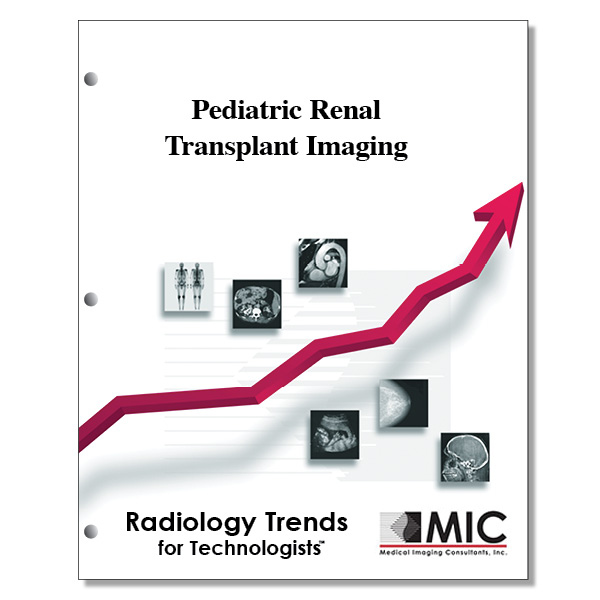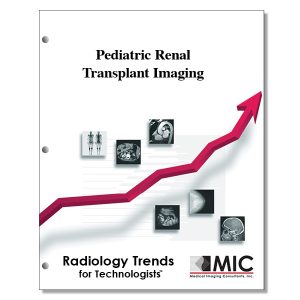

Pediatric Renal Transplant Imaging
A review of the imaging appearances of pediatric renal transplants and their common complications.
Course ID: Q00396 Category: Radiology Trends for Technologists Modalities: CT, MRI, Nuclear Medicine, Sonography, Vascular Interventional3.75 |
Satisfaction Guarantee |
$37.00
- Targeted CE
- Outline
- Objectives
Targeted CE
Targeted CE per ARRT’s Discipline, Category, and Subcategory classification for enrollments starting after May 25, 2023:
[Note: Discipline-specific Targeted CE credits may be less than the total Category A credits approved for this course.]
Computed Tomography: 2.75
Procedures: 2.75
Abdomen and Pelvis: 2.75
Magnetic Resonance Imaging: 3.75
Patient Care: 1.00
Patient Interactions and Management: 1.00
Procedures: 2.75
Body: 2.75
Nuclear Medicine Technology: 3.75
Patient Care: 1.00
Patient Interactions and Management: 1.00
Procedures: 2.75
Gastrointestinal and Genitourinary Procedures: 2.75
Registered Radiologist Assistant: 3.75
Procedures: 3.75
Abdominal Section: 3.75
Sonography: 3.75
Patient Care: 1.00
Patient Interactions and Management: 1.00
Procedures: 2.75
Abdomen: 2.75
Vascular-Interventional Radiography: 3.00
Procedures: 3.00
Vascular Diagnostic Procedures: 1.00
Vascular Interventional Procedures: 1.00
Nonvascular Procedures: 1.00
Vascular Sonography: 3.75
Patient Care: 1.00
Patient Interactions and Management: 1.00
Procedures: 2.75
Abdominal/Pelvic Vasculature: 2.75
Outline
Outline
- Introduction
- Surgical Technique
- Postoperative and Surveillance Imaging
- The Normal Renal Allograft
- Posttransplant Complications
- Perinephric Fluid Collections
- Hematoma and Seroma
- Graft Infection and Abscess
- Lymphocele
- Vascular Complications
- Renal Artery Thrombosis and Renal Infarction
- Renal Vein Thrombosis
- Renal Artery Stenosis
- Arteriovenous Fistulas and Pseudoaneurysms
- Urologic Complications
- Urine Leak and Urinoma
- Urinary Tract Obstruction
- Vesicoureteral Reflux
- Abnormalities of Graft Function
- Acute Tubular Necrosis
- Rejection
- Hyperacute Rejection
- Acute Rejection
- Chronic Rejection
- Toxic Effects of Calcineurin Inhibitors
- Recurrent Disease
- Mass Lesions
- Posttransplant Lymphoproliferative Disease
- Inflammatory Myofibroblastic Tumor
- Conclusions
Objectives
Objectives
Upon completion of this course, students will:
- understand the complementary roles of US and nuclear medicine in characterizing post-transplant complications
- identify the perinephric fluid collections associated with renal transplantation
- know the role renal scintigraphy plays in elucidating common complications including urine leak and urinary tract obstruction
- identify the predominant cause of end-stage renal disease during infancy and childhood
- be familiar with the number of pediatric patients undergoing renal transplantation on an annual basis
- know who is credited with the construction of the first renal dialyzer
- be familiar with the year the first dialyzer was constructed
- know the mainstay for imaging renal transplants in children
- identify the most commonly used radiopharmaceutical for renal perfusion
- be familiar with deterrents for using CT on pediatric renal transplantation patients
- be familiar with the normal thickness of the walls on the renal pelvis when performing US
- be familiar with the normal range of the US resistive index in the arterial system of the kidney
- be familiar with the normal time-to-peak activity when performing renal scintigraphy
- identify the date of the first successful renal transplantation
- be familiar with the physician who is credited with the first renal transplantation
- identify the most common immunosuppressive medications for renal transplantation
- be familiar with the discovery and role of cyclosporine
- be familiar with late phase renal transplant complications
- be familiar with the renal transplant complications associated with rejection
- be familiar with the characteristics of the Page kidney
- identify the characteristics of a pseudorejection on renal scintigraphy
- identify the most common cause of allograft infection in renal transplantation
- be familiar with the characteristics of 99mTc-DMSA
- identify the causes of perinephric abscesses in renal transplantation
- be familiar with the ultrasound findings associated with pyonephrosis
- be familiar with the nuclear medicine examination used to distinguish lymphoceles from urinomas
- be familiar with the hormones produced by the kidneys
- identify the basic functional unit of the kidney
- be familiar with the most common cause of 1st year allograft loss in children
- identify the procedures that may be used when renal artery thrombosis occurs during renal transplantation
- be familiar with the sensitivity of ACE-inhibited renal scintigraphy for diagnosing renal artery stenosis after renal transplantation
- understand the criteria for treating pseudoaneurysms during renal transplantation
- understand the characteristics of 99mTc-DTPA
- identify the renal radiopharmaceuticals used for morphological imaging
- be familiar with the distribution of 99mTc-DMSA
- be familiar with the complications of vesicoureteral reflux during renal transplantation
- be familiar with the characteristics of a urine leak during 99mTc-mertiatide renal scintigraphy
- identify which medical imaging tests are invaluable in the determination of post-transplant urinary tract infection
- be familiar with the causes of delayed graft function during renal transplantation
- be familiar with the basis for characterizing renal allograft rejection
- identify immunosuppressant agents that act as calcineurin inhibitors
- understand the patient preparation for renal scintigraphy
- be familiar with the areas of the body affected by post-transplant lymphoproliferative disease
- identify the procedure used to provide a definitive diagnosis of an inflammatory myofibroblastic tumor
- be familiar with the renal scintigraphy positioning of a patient that has had renal transplantation
